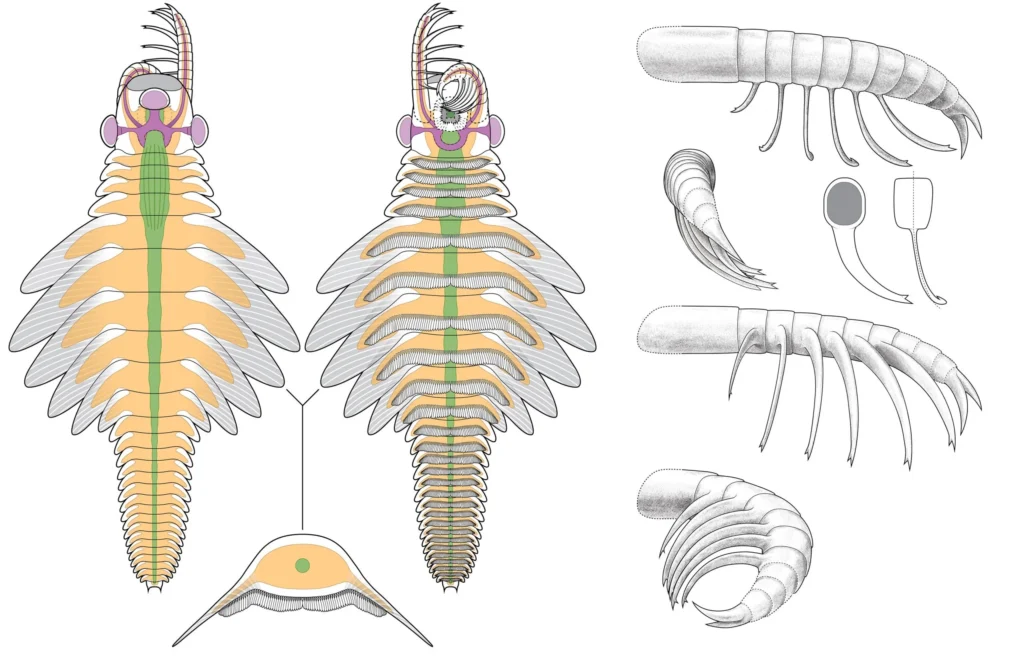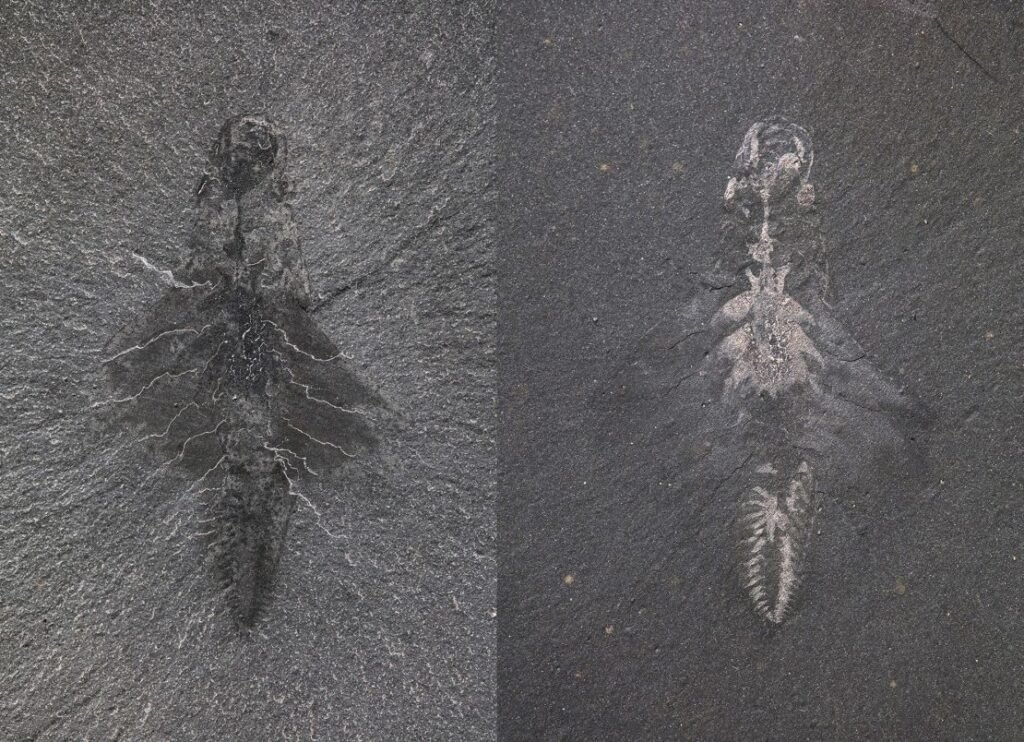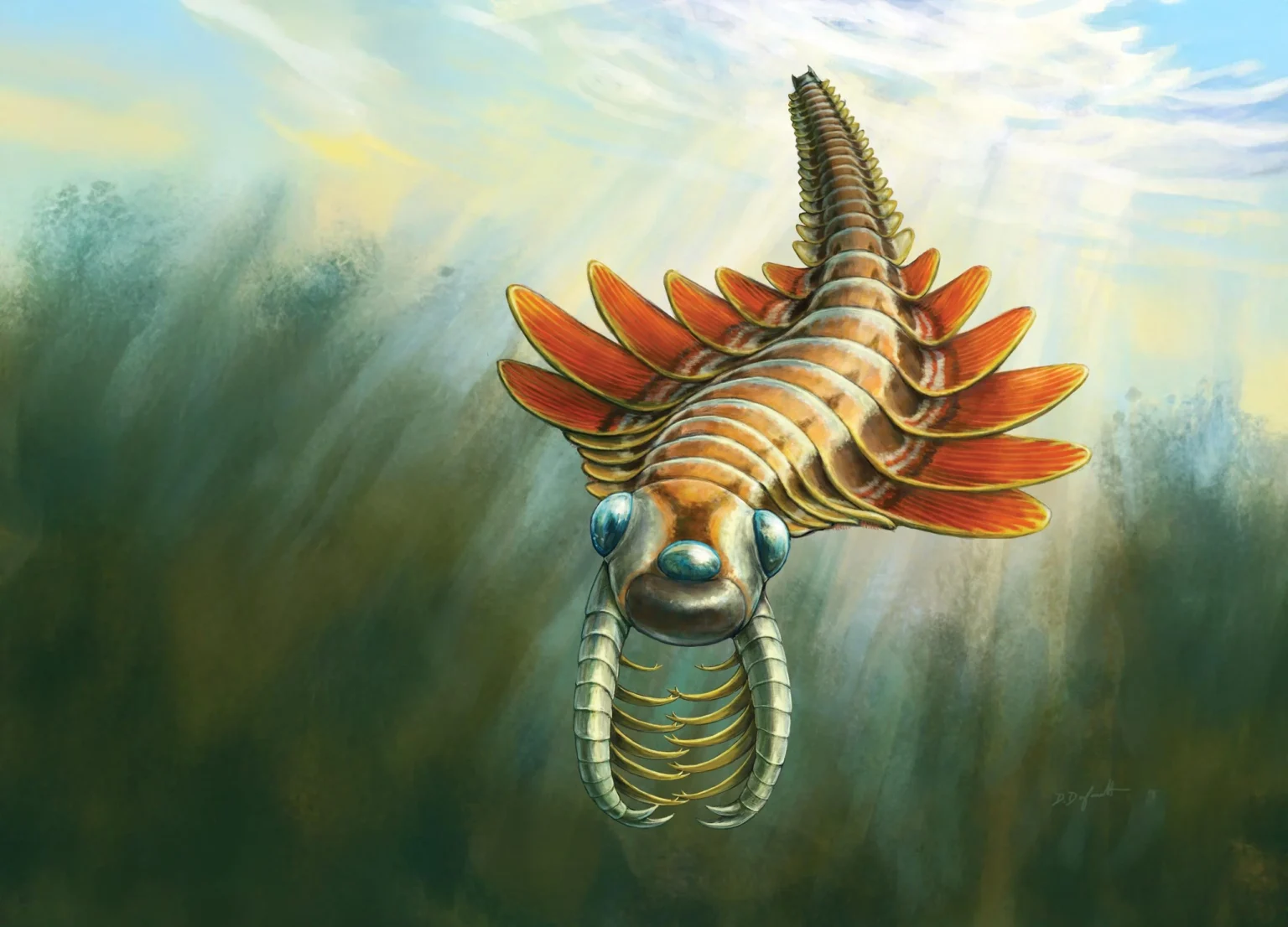Mosura fentoni Discovery: Unearthing a Cambrian Sea Predator
In the depths of Canada’s fossil-rich Burgess Shale, a team of paleontologists has made the groundbreaking Mosura fentoni discovery—a truly fascinating prehistoric creature. This tiny marine animal, belonging to the ancient group of radiodonts, has added a new dimension to our understanding of early marine life. Unlike its more fearsome and larger relatives, Mosura fentoni reveals that even small creatures of the Cambrian seas were biologically complex and evolutionarily advanced.

The Mosura fentoni discovery is much more than just another fossil; it’s a window into how evolution experimented with form, function, and survival strategies over 500 million years ago.
A Glimpse into the Cambrian Explosion
The Cambrian period, roughly 541 to 485 million years ago, was a time of explosive diversification in life forms. Known as the “Cambrian Explosion,” this period saw the emergence of nearly all major animal groups. Fossils from this era are vital to piecing together the tree of life and understanding the origin of complex organisms.
The Mosura fentoni discovery contributes significantly to this narrative by providing rare insight into the anatomy and ecology of small, specialized predators that lived in ancient marine ecosystems. It stands as a testament to the diversity and adaptability of early arthropods, a group that would later dominate much of the animal kingdom.
What is Mosura fentoni? A Radiodont with a Twist
Mosura fentoni is classified as a radiodont, a group of early arthropods known for their segmented bodies, frontal appendages, and circular mouths filled with tooth-like plates. Famous radiodonts like Anomalocaris were once thought to be the apex predators of Cambrian seas.
However, Mosura fentoni breaks the mold. It’s considerably smaller than its better-known relatives and exhibits unique features that challenge traditional assumptions about radiodont morphology. These features include:
- A streamlined body adapted for efficient swimming
- Highly developed gill structures, indicating an advanced breathing system
- A compact size, suggesting it occupied a different ecological niche from larger radiodonts
This discovery reshapes what scientists previously believed about the ecological roles radiodonts could play.
How the Mosura fentoni Discovery Was Made
The fossil of Mosura fentoni was excavated from the Burgess Shale, a geological formation located in the Canadian Rockies of British Columbia. This site is renowned for its exceptional preservation of soft-bodied marine animals from the Cambrian period.
Paleontologists Joseph Moysiuk and Jean-Bernard Caron led the study, meticulously analyzing the fossil’s delicate structures. Using advanced imaging techniques, they were able to identify fine anatomical details that set Mosura fentoni apart from other known species.
The Mosura fentoni discovery is an example of how modern technology, combined with classic fieldwork, can reveal extraordinary details from deep time.
Advanced Breathing System: A Biological Innovation
One of the most surprising aspects of Mosura fentoni is its sophisticated respiratory system. While earlier radiodonts were thought to rely on basic diffusion across body surfaces to absorb oxygen, Mosura fentoni reveals a different story.

The fossil shows clearly defined gill blades, suggesting a far more efficient method of gas exchange. This level of specialization is rare for animals of that period and size.
This breakthrough implies that evolutionary experiments with advanced breathing structures were happening far earlier than previously assumed. It also raises the possibility that other small Cambrian organisms may have had similarly complex physiology that has yet to be discovered.
Mosura fentoni vs. Anomalocaris: A Comparative Analysis
To truly appreciate the significance of the Mosura fentoni discovery, it’s essential to compare it with its radiodont relatives, particularly the iconic Anomalocaris. While both are members of the same ancient lineage, their differences are stark and informative.
| Feature | Mosura fentoni | Anomalocaris |
|---|---|---|
| Size | Small (less than 10 cm) | Large (up to 1 meter) |
| Body Shape | Streamlined, narrow | Broad and segmented |
| Respiratory System | Advanced gill blades | Simple body diffusion |
| Ecological Role | Likely mid-level predator | Apex predator |
This comparison highlights the diverse evolutionary pathways radiodonts explored, suggesting a level of adaptability that may have contributed to the later success of arthropods.
Why Size Doesn’t Limit Complexity
One of the key takeaways from the Mosura fentoni discovery is the realization that small size doesn’t mean evolutionary simplicity. In fact, the compact body of Mosura fentoni allowed for enhanced maneuverability, enabling it to navigate complex underwater environments in search of prey.
Its sophisticated gills also imply a high metabolic rate, which would have supported a more active lifestyle. This stands in contrast to the traditional view that only large animals could afford to be biologically complex during the Cambrian period.
The Ecological Role of Mosura fentoni in Cambrian Seas
Based on its anatomical features, researchers believe that Mosura fentoni was a mid-level predator, feeding on smaller invertebrates and possibly planktonic organisms. Its efficient swimming ability and sharp frontal appendages suggest a hunting strategy that involved chasing down or ambushing prey.
In the dynamic ecosystems of the Cambrian seas, Mosura fentoni likely played a critical role in maintaining ecological balance, preventing smaller species from overpopulating and serving as prey for larger predators.
Implications for Arthropod Evolution
The Mosura fentoni discovery significantly impacts our understanding of how modern arthropods—like insects, spiders, and crustaceans—came to be. Arthropods are the most diverse and numerous animals on the planet today, and this discovery shows that their evolutionary roots were already deeply innovative during the Cambrian.
Mosura fentoni demonstrates:
- Early divergence in body plans
- Experimental respiratory adaptations
- Varied feeding strategies
These traits suggest that the foundation for modern arthropod diversity was established far earlier than previously recognized.
Preserving Fossil Sites Like the Burgess Shale
Without fossil sites like the Burgess Shale, the Mosura fentoni discovery would never have been possible. This site’s unique conditions—fine sediment, low oxygen, and rapid burial—allowed for the extraordinary preservation of soft-bodied animals.

Continued exploration and conservation of such sites are crucial for future discoveries. They provide an irreplaceable record of Earth’s early life and offer critical insights into how evolution works over deep time.
The Role of Technology in Fossil Analysis
Modern techniques such as scanning electron microscopy (SEM) and synchrotron imaging have revolutionized how fossils like Mosura fentoni are studied. These methods allow paleontologists to view microstructures that are otherwise invisible, enabling more accurate reconstructions of ancient organisms.
In the case of Mosura fentoni, such technology helped scientists identify its gill blades, fine setae, and the articulation of its swimming flaps—details crucial for understanding its lifestyle.
Public Fascination with Cambrian Creatures
Since the announcement of the Mosura fentoni discovery, public interest in Cambrian sea life has surged. People are fascinated by these ancient, alien-looking creatures that once ruled the oceans.
The visual reconstructions by artists like Joseph Moysiuk and Jean-Bernard Caron help bridge the gap between scientific discovery and public imagination, sparking curiosity and appreciation for Earth’s distant past.
Conclusion: Why the Mosura fentoni Discovery Matters
The discovery of Mosura fentoni is not just a fascinating addition to the fossil record—it’s a paradigm-shifting find. It challenges longstanding assumptions about early arthropods and reveals that even the smallest creatures of the Cambrian seas were surprisingly complex.
This discovery enhances our understanding of:
- The evolutionary pathways that led to modern arthropods
- The diversity of life during the Cambrian period
- How adaptation and specialization evolved in marine ecosystems
As more discoveries emerge from fossil beds around the world, the story of life’s origins continues to evolve. The Mosura fentoni discovery reminds us that even the tiniest fossils can hold the biggest secrets of life on Earth.




